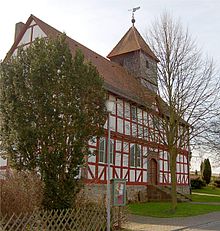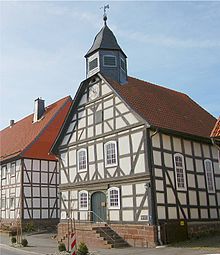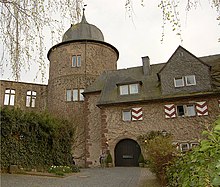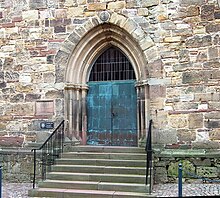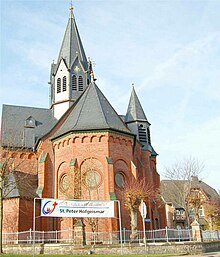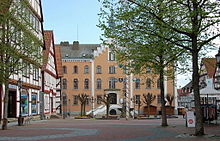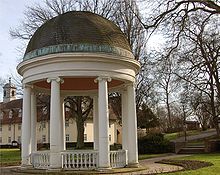Hofgeismar
| coat of arms | Germany map | |
|---|---|---|

|
Coordinates: 51 ° 30 ' N , 9 ° 23' E |
|
| Basic data | ||
| State : | Hesse | |
| Administrative region : | kassel | |
| County : | kassel | |
| Height : | 157 m above sea level NHN | |
| Area : | 86.39 km 2 | |
| Residents: | 15,268 (Dec. 31, 2019) | |
| Population density : | 177 inhabitants per km 2 | |
| Postal code : | 34369 | |
| Primaries : | 05671, 05675 (Hümme) | |
| License plate : | KS, HOG, WOH | |
| Community key : | 06 6 33 013 | |
| LOCODE : | DE HGM | |
| City structure: | 8 districts (including core city) | |
City administration address : |
Markt 1 34369 Hofgeismar |
|
| Website : | ||
| Mayor : | Markus Mannsbarth ( SPD ) | |
| Location of the city of Hofgeismar in the Kassel district | ||
Hofgeismar is a small town in the north Hessian district of Kassel with almost 15,000 inhabitants.
geography
Hofgeismar is located in the Hofgeismarer Rötsenke about 21 km north-northwest of Kassel . It is located immediately southeast of the Hofgeismar city forest between Trendelburg in the north and Grebenstein in the south, directly above the confluence of the Lempe and the Esse . The municipality extends between 124 m (on the Esse) and 392 m above sea level. NN (in the Hofgeismar city forest on the Heuberg ; with television tower), the core city is at an average height of 165 m .
Neighboring communities
Hofgeismar borders in the north on the city of Trendelburg , in the east on the community-free area " Gutsiertel Reinhardswald ", in the south on the city of Grebenstein and in the west on the city of Liebenau (all in the Kassel district).
City structure
Hofgeismar includes not only the core town of Hofgeismar but also the districts
- Beberbeck with the Sababurg district
- Carlsdorf
- Friedrichsdorf
- Hombressen
- Hümme
- Kelze
- Schöneberg
The districts (apart from the core city) are separate local districts and form local advisory boards.
history
Archaeological finds testify to a continuous settlement of the urban area for about 7000 years.
Hofgeismar is mentioned as Hovegeismari in a document from Archbishop Sigfrid I of Mainz in 1082 . At that time, however, there was a “ Fronhof ” for 300 years , which is still remembered today by a street name (“Am Fronhof”). Since the 9th century the "Hof Geismar" belonged to the Franconian Empire and after a donation to the Archdiocese of Mainz .
The settlement "Hove Geismari" received city rights in 1223 by Archbishop Sigfried II of Mainz , after it had already developed into the center of a church district. The archdeacon's seat existed with a collegiate pen at the Old Town Church of Our Lady, which had been consecrated to Mary, the Mother of God. The secular power of the Archbishops of Mainz in the area of Diemel and Upper Weser also included the nearby Schöneberg fortress , which was built at the beginning of the 12th century. The Mainz wheel in the coat of arms of the city and of the wealthy Geismar family reminds of this time to this day . The founding years of the city in the 13th century include not only the Hofgut with a permanent house of the court lord ("Sala"), monastery and priory buildings as well as settlements in the old town, the new town and the Petristadt. Parts of the town hall vault, the tower (defense tower) of the old town church and the partially preserved city fortifications, which at that time consisted of an approximately five meter high wall with battlements and trenches in front, date from this time .
The castle in today's Sababurg district , which Landgrave Wilhelm I had expanded into a hunting lodge and stud from 1490 , also dates from the 13th century . Landgrave Wilhelm IV (Hessen-Kassel) founded the Sababurg zoo at the foot of the Sababurg in 1571 .
During the Mainz collegiate feud (1461–1463) Hofgeismar had to endure a siege of several weeks by Landgrave Ludwig II of Hesse, who was allied with the new Archbishop Adolf von Nassau-Wiesbaden-Idstein , because of his loyalty to Archbishop Diether von Isenburg, who had been deposed by the Pope ; The castle Schöneberg , which was also besieged , only surrendered after the besiegers had plundered the area and shot the buildings on the castle hill to rubble.
War debts from the collegiate feud meant that the Mainz possessions between Diemel and Weser had to be pledged by Archbishop Adolf II to Landgrave Ludwig II in 1462; Hofgeismar also came into Hessian possession. Although the citizens vehemently opposed to sinking into a freely available pledge of the archbishop, the landgrave overpowered the city militarily and nevertheless captured it. Under Landgrave Philip I , Hesse became Protestant in 1526 as a result of the Homberg Synod . The Canon Monastery and the Franciscan Monastery in Hofgeismar were dissolved. After Philip's death, Hofgeismar came to the Landgraviate of Hessen-Kassel under Philip's eldest son, Wilhelm IV , on the basis of the inheritance he had ordered . After the Merlau Treaty of 1582 between Wilhelm IV and the new Archbishop of Mainz, Wolfgang von Dalberg , Hofgeismar finally belonged to the Landgraviate Hessen-Kassel.
By the Thirty Years War , the number of inhabitants in Hofgeismar grew to around 2500 people. The half-timbered buildings of the city that have survived to this day date partly from the 17th century.
Hofgeismar also suffered greatly from the turmoil of the Thirty Years War. Initially, from 1623 onwards, approx. 1000 foot troops, horsemen and artillery from General Tilly as an occupying force were camped in the city for about 7½ years . In 1635, Swedish troops set fire to Hofgeismar. An attack on August 31, 1637 was successfully repulsed by the Hessian garrison troops under Rittmeister Hans Ellenberger and the residents themselves. In 1642 and 1647 the city suffered heavy looting again. The population fell to about a third of the pre-war number.
In the second half of the 17th century, Landgrave Karl also settled French religious refugees ( Huguenots ) in Hofgeismar , who had left their homeland in 1685 after the Edict of Fontainebleau and the abolition of religious freedom in France. Huguenots and Waldensian refugees also found a new home here, who had been expelled in 1698 on the orders of Louis XIV . On February 22nd, 1686, a French Reformed community was founded in Hofgeismar. In the following years Huguenot settlements were also founded in the area, such as B. Carlsdorf (1686), Kelze and Schöneberg (both 1699) and Friedrichsdorf (1775).
Since 1686 the church services of the German Reformed community as well as the French Reformed Christians have been held in the Hofgeismarer Neustädter Church . The first pastor of the French community, David Clément, died on January 29, 1725 in Hofgeismar, which is remembered by a plaque on the Neustadt church and a memorial near it.
There is evidence of a Jewish community in Hofgeismar in the second half of the 18th century, which built a synagogue in the Petriplatz / Loghagen area in 1764 . Individual city residents of Jewish faith were mentioned in a document as early as 1470 in Hofgeismar. They initially belonged to the entire community of all Jews in the Landgraviate of Hesse-Kassel. In 1783, the Hofgeismar Jewish community had 107 members; their number rose to 219 by 1861.
In the 18th century, Hofgeismar and the Gesundbrunnen district became a seaside resort. The buildings around the mineral spring are reminiscent of this to this day. The source of the Gesundbrunnen is said to have been discovered by a wounded soldier during the Thirty Years' War and to have brought him the hoped-for healing. The Schönburg Castle ("Montcherie") in the Gesundbrunnen Park , built from 1787 to 1789 in a classicist style based on plans by Simon Louis du Ry , was originally the residence of Landgrave Wilhelm IX. (since 1803: Elector Wilhelm I) during his stays in the summer months. Today the entire area belongs to the Evangelical Church of Kurhessen-Waldeck and is home to the Evangelical Academy Hofgeismar . In addition to the buildings of the Evangelical Academy, there are also old people's and nursing homes at Gesundbrunnen.
The Seven Years' War brought considerable economic damage for Hofgeismar, especially during the trench warfare on the Diemel from 1760 to 1762; Hessian troops fought against France for England's pay .
From 1808 Hofgeismar belonged under French rule to the Kingdom of Westphalia , which was created with King Jérôme , the youngest brother of Napoléon Bonaparte , as regent. After the Battle of the Nations near Leipzig , the existence of this work of art ended and the Landgraviate of Hessen-Kassel was restored. Under Elector Wilhelm II and his son Friedrich Wilhelm I , the construction of the Friedrich-Wilhelms-Nordbahn from Karlshafen via Kassel to Bebra began in 1844 . In the area of the city of Hofgeismar, now also a garrison town and post station, a reception building for the new railway line was built in 1848; Another train station was built in what is now the Hümme district .
The Friedrich-Wilhelms-Nordbahn was the first Hessian railway line. The first section, the Grebenstein - Hümme - Karlshafen line, was opened on March 30, 1848 , the so-called Carlsbahn , which was the only railway connection from Kassel to a Weser port (Karlshafen). The Landgraviate of Hessen-Kassel became extinct in 1866 when it was annexed by Prussia as a result of the German War . With that, the city of Hofgeismar also came to Prussia. After the Prussian annexation, the Friedrich-Wilhelms-Nordbahn was renamed "Hessische Nordbahn". The Staatsbad Gesundbrunnen was dissolved.
The Meyersche Konversationslexikon describes in its 4th edition from 1885 to 1892 the city of Hofgeismar as a "district town in Prussia. Kassel administrative district, on the Esse and the Schwerte-Kassel line of the Prussian State Railroad, has 2 Protestant parish churches, a district court, a secondary school, book and lithographic printing, malt production, alcohol distillery, a chemical factory, woodcutters, brickworks, a factory for military plaster effects, significant forests and (1885) with garrison (a dragoon regiment No. 5) 4343 mostly Protestant inhabitants. "
From stationed in Hofgeismar Hesse hussars was 1867 first first Hessian Hussar Regiment. 13 emerged. It was followed in 1875 by the Dragoon Regiment No. 5, which was later named Dragoon Regiment "Freiherr von Manteuffel" (Rhenish) No. 5 .
The Catholic parish pastoral care in the strongly evangelical town began in 1892. The construction of the Catholic St. Petri Church followed in 1897/1898, because the chapel initially set up in a house on Niedermeiser Strasse had proven to be too small. The Catholic rectory was added in 1906. Before that, monthly services for the Catholic members of the garrison and some civilians had already been held in the Old Town Church in the last third of the 19th century . Only after the Second World War did the number of the Catholic population rise sharply due to the influx of many refugees - especially from the Sudetenland ( Czech Republic ) - in the former Hofgeismar district up to around 22,000 believers in 1948.
According to a census in 1868, the population in Hofgeismar was 3708 people (including 750 soldiers ); it rose to 4600 inhabitants by 1906.
In 1923 the city was the garrison site of the 16th Cavalry Regiment of the Reichswehr .
The time of National Socialism is also an inglorious chapter in Hofgeismar's history. In the elections on September 14, 1930, the NSDAP was the second largest party in the city. The SA (in Hofgeismar: Sturm 86) had its meeting point in the former button factory of the Buto-Werke in Fürstenweg not far from Bahnhofstrasse (later: Adolf-Hitler- Strasse).
According to a report in the Protestant “Kasseler Sonntagsblatt” on April 9, 1933, the farmer Rompf (NSDAP) was elected head of the city council of Hofgeismar at the meeting of the newly elected city parliament. On May 13, 1934, the Sunday newspaper reported in a short message about the introduction of the new mayor of Hofgeismar, Rödde, the then district leader of the NSDAP.
Also in Gau Kurhessen were social democrats and communists persecuted by the new regime, but especially Jews. The Hofgeismar synagogue from 1764 was completely devastated on the night of November 9-10, 1938 . On the homepage of the Stadtmuseum Hofgeismar the names (for wives also the birth name), the year of birth and the deportation destination of 453 Jewish victims of the Nazi period are noted, who come from the towns and communities of the former districts of Hofgeismar, Kassel and Wolfhagen.
The Second World War ended after the Wehrmacht had withdrawn from the population of Hofgeismar on April 7, 1945 with the invasion of soldiers from the 2nd US Infantry Division and the 9th US Armored Division .
From 1821 to 1972 Hofgeismar was the district town of the former Hofgeismar district and since 1972 the city has been part of the Kassel district. In 1978 she was the host of the Hessentag 1978 .
During the Cold War , the Manteuffel barracks in Hofgeismar was the location of the Bundeswehr headquarters of the Armored Brigade 6 from 1981 to 1993, the repair company 60 (1986 to 1993) and the 5th company of the repair battalion 330.
In 2015 Hofgeismar was again the host of the Hessentag after 1978 .
Population development
|
|
Incorporations
In the course of administrative reform in Hesse on 31 December 1970, the previously independent municipalities were Beberbeck (with Sababurg ) Carlsdorf , Friedrichsdorf , Hombressen , Hümme and Schöneberg voluntarily incorporated . Kelze joined on February 1, 1971.
politics
City Council
The local elections on March 6, 2016 produced the following results, compared to previous local elections:
| Parties and constituencies |
% 2016 |
Seats 2016 |
% 2011 |
Seats 2011 |
% 2006 |
Seats 2006 |
% 2001 |
Seats 2001 |
||
|---|---|---|---|---|---|---|---|---|---|---|
| SPD | Social Democratic Party of Germany | 48.7 | 18th | 44.9 | 17th | 35.3 | 13 | 42.7 | 16 | |
| CDU | Christian Democratic Union of Germany | 28.2 | 10 | 38.3 | 14th | 50.1 | 19th | 45.6 | 17th | |
| WSD | Voter community social democrats | 12.0 | 5 | 8.9 | 3 | 6.6 | 2 | - | - | |
| LEFT | The left | 5.6 | 2 | 4.6 | 2 | - | - | - | - | |
| FDP | Free Democratic Party | 5.4 | 2 | 3.4 | 1 | 2.6 | 1 | 3.3 | 1 | |
| WASG | Labor & Social Justice - The Alternative Choice (from June 2007 merger with Die Linke) | - | - | - | - | 5.5 | 2 | - | - | |
| total | 100.0 | 37 | 100.0 | 37 | 100.0 | 37 | 100.0 | 37 | ||
| Voter turnout in% | 48.0 | 49.6 | 49.8 | 56.6 | ||||||
mayor
According to the Hessian municipal constitution, the mayor is the chairman of the magistrate , which in the city of Hofgeismar includes nine honorary councilors in addition to the mayor . Markus Mannsbarth ( SPD ) has been mayor since 2015 .
Former mayors:
- 1997-2014 Heinrich Sattler ( CDU )
- 1991–1996 Horst Buchhaupt (SPD)
- 1976–1990 Willi Croll (SPD)
- 1966–1976 Gerhard Kuske ( GDP )
- 1948–1966 Walter George (CDU)
- 1945–1948 Hermann Weidemann (SPD)
- 1934–1942 Wilhelm Ludwig Rödde ( NSDAP )
- 1919-1933 Max Laneus
- 1906-1919 Hottejan
coat of arms
|
The coat of arms of Hofgeismar shows silver Gothic architectural elements in red, including a silver wheel. The " Mainz wheel " refers to the fact that the city belonged to the bishopric of Mainz until 1462. |
|
Town twinning
- Pont-Aven , France, since 1972
- Rosenau , Austria, since 1983
- Maringues , France, since 1984
- Bad Blankenburg , Thuringia, Germany, since 1990
Culture and sights
Buildings
Architecture and sculptures in the old town
- Town hall from the 14th century, rebuilt in the 19th century
- numerous half-timbered houses :
- Café Hoffmann - probably the oldest half-timbered house in the city, 1528, Markt 19
- House Malzfeldt - Diemelsächsisches Ackerbürgerhaus, longitudinal hall house, 1684, Petristraße 13
- House Scheffer - Long hall house in mixed construction, 1684, Steinweg 18
- Wedding house , former municipal guild and wedding house, built in 1620
- Sculptures in the pedestrian zone
- Cube tower legend: The two life-size bronze sculptures represent the two representatives of Hesse and Braunschweig, who - according to the legend - threw the dice for Hofgeismar's holdings in 1401. Hofgeismar won with 18 to 17 dice eyes.
- Pottery Fountain
- A sculpture by David Clément , a bibliographer who was born in Hofgeismar in 1701 and whose grave is in the Neustädter Church, stands near the Neustädter Church on the corner of Elisabethstrasse and Johannesstrasse .
Attentive observers will discover stumbling blocks in the sidewalk in front of some houses .
Churches
- Old town church from the 12th to 14th centuries
- Neustadt church from the years 1341–1421
- St. Peter , Catholic Church from 1898
Healthy well
- Park at Gesundbrunnen with Schönburg Castle ("Montcherie", today Evangelical Academy)
Museums
- Pharmacy museum in the stone house from the 13th century. The pharmacy museum shows u. a. three complete, faithfully preserved pharmacy offices from the years 1768, 1801 and 1945.
-
Stadtmuseum Hofgeismar in the overall complex Petriplatz 2 (four houses from four epochs, built from approx. 1500)
The city museum shows in 14 departments u. a. the history of the Huguenots and Waldensians in and around Hofgeismar (with a rich collection of Huguenot Bible editions and religious writings); Jewish culture in Northern Hesse; Guilds, crafts and economic history from the 15th to the 19th century; the health resort Gesundbrunnen; Hofgeismar as a garrison town and - from an inventory of 650 originals - paintings by Theodor Rocholl .
In the surrounding districts
- Schöneberg castle ruins on the Schöneberg north of the city
- The Sababurg in the neighboring Reinhardswald is a well-known excursion destination with the Sababurg Zoo and the nearby Sababurg Primeval Forest .
Hofgeismar is also located on the German Fairy Tale Route , which leads from Hanau via Hofgeismar to Bremen.
Hofgeismar was the venue for the 18th and 55th Hessentag in 1978 and 2015 . In 1978 there were approx. 300,000 guests, in 2015 the organizers counted around 750,000 visitors.
Economy and Infrastructure
traffic
Road traffic
The federal road 83 , which previously ran directly through the village, runs east past Hofgeismar as a local bypass, which was approved in 2013 . The federal motorway 44 is about 20 km from the city at the Breuna junction .
Hofgeismar is a station on the Hessian long-distance cycle route R4 .
Public transport
Hofgeismar station is on the Kassel – Warburg railway line . The main station building still consists of the first building that Julius Eugen Ruhl built in 1846/47, but which was massively rebuilt in 1939. The station is served by RegioTrams on the RT1 line and the regional express trains on the RE11 ( Rhein-Hellweg-Express ) and, more rarely, the RE17 ( Sauerland-Express on the Kassel-Wilhelmshöhe - Düsseldorf Hbf / Hagen Hbf ) route. The journey time from Kassel main station to Hofgeismar is about half an hour with the RegioTram, with the RE trains from Kassel-Wilhelmshöhe it is about 20 minutes. According to the Federal Transport Infrastructure Plan 2030 , the current preliminary operation of the RE11 is to be integrated into the network of the Rhein-Ruhr-Express (RRX 2) and thus also include the Hofgeismar station.
At the station Hofgeismar-Hümme , about five more km towards Warburg, the chain Carl's Railway from. Only the RegioTram Kassel stops here .
Hofgeismar has a dense city bus network that is linked to various lines from the region at the central bus station and belongs to the North Hessian transport association.
health
There are two hospitals in Hofgeismar : The Hofgeismar District Clinic and the Evangelical Hospital Gesundbrunnen .
Companies
- AKG group
- BrainLogical Software Development, online marketing agency
- CMAC GmbH & Co. Verlags KG (OWZ-Verlags GmbH), belongs to the media group Lalé-Schiffner
- Evangelisches Krankenhaus Gesundbrunnen gGmbH - Center for Geriatrics and Neurology
- FTH Fertigungstechnik Hofgeismar GmbH
- Friedrich-Sander Rental and Administration GmbH & Co. KG
- Günter Herrmann teaching material factory, owner: Bernhard Herrmann
- HKS Software + Computersysteme GmbH
- Management Services Helwig Schmitt GmbH, market analysis systems for the automotive industry
- Martin Löber GmbH ( Hagebaumarkt )
- Messtechnik Neth GmbH
- Agricultural livestock and meat marketing Kassel-Hofgeismar eG
- Sander Haus Holzbau GmbH
- Siebenhaar Antriebstechnik GmbH
- SLS tuning
- Wiking inflatable boat yard Hanel GmbH
- WK Windkraft-Kontor GmbH + Co. Pluzunet / Ostbevern KG
education
The following educational institutions are located in Hofgeismar:
- Albert Schweitzer School, grammar school
- Gustav Heinemann School, comprehensive school
- Cube tower school, elementary school with two locations in Unteren Graben and in Garrisonstraße
- Primary school Hombressen "Zur Friedenseiche"
- Primary school Hümme "Wiesenbergschule"
- Herwig Blankertz School, district vocational and vocational school
- Brothers Grimm School, special school for learning assistance
- Käthe-Kollwitz-Schule, school for the practically imaginable with a department for the physically disabled
- Evangelical geriatric nursing school
Personalities
Honorary citizen
- 1895 Otto von Bismarck (1815–1898), Reich Chancellor
Sons and Daughters of the City (chronological)
- Burkard Waldis (1490–1556), theologian
- Johann Westermann (1490–1542), theologian
- Johann Doläus (1651–1707), medic
- David Clément (1701–1760), Reformed clergyman
- Johann Westermann (1741–1784), baroque poet
- Johannes Bering (1748–1825), Enlightenment philosopher
- Heinrich Wilhelm Hartwig (1792–1863), Lord Mayor of Kassel (1848–1863)
- Wilhelm Leopold von Heister (1795–1863), Prussian major general
- George Dedolph (1789–1843), jurist from the Electorate of Hesse , member of the Assembly of Estates in the Electorate of Hesse
- Georg Wilhelm von Wetzell (1815–1890), legal scholar, university professor and state minister
- Ernst Wilhelm Klinkerfues (1827–1884), astronomer and meteorologist
- Nataly von Eschstruth (1860–1939), writer
- Max von Loewenstein zu Loewenstein (1870–1949), district administrator
- Hermann Kätelhön (1884–1940), draftsman and graphic artist
- Heinrich Dersch (1889–1967), expressionist painter
- Heinrich Zerkaulen (1892–1954), writer
- Hermann Recknagel (1892–1945), German infantry general killed in World War II
- Theodor Bogler (1897–1968), ceramist and Benedictine priest
- Hans Gerhard Evers (1900–1993) German art historian
- Hermann Mattern (1902–1971), one of the most important German landscape architects of the 20th century
- Friedrich Wilhelm Bogler (1902–1945), painter
- Gustav Siewerth (1903–1963), philosopher and educator
- Wilhelm Hugues (1905–1971), painter and graphic artist
- Joachim Günther (1905–1990), publicist and editor
- Johann Adolf Graf von Kielmansegg (1906–2006), German general
- Gerhard Kuske (1911–2001), former mayor of Hofgeismar (September 1, 1966 to August 31, 1976)
- Hartmut Gründler (1930–1977), environmental protection pioneer
- Fritz Kersten (1935-2005), politician (FDP)
- Pit Morell (* 1939), painter and storyteller
- Karl Heinz Götze (* 1947), Germanist
- Angelika Dörfler-Dierken (* 1955), church historian
- Hartmut Riemenschneider (* 1958), Baptist pastor and President of the Federation of Evangelical Free Churches
- Wolfgang Köhler (* 1960), jazz pianist
- Martin Zielke (* 1963), bank manager
- Jens Dietrich (* 1976), dramaturge
- Carl Jakob Haupt (1984–2019), blogger
- Stefan Ortega Moreno (* 1992), football player
- Pimf alias Jonas Kramski (* 1993), rapper
literature
- Richard Andrae: The city of Hofgeismar in the 19th century . Verlag der Stadt, Hofgeismar 1954. Published as the second volume of the history of the city of Hofgeismar (see below, under Friedrich Pfaff).
- Friedrich Bleibaum (Ed.): District Hofgeismar (= Handbook of the Heimatbund for Kurhessen, Waldeck and Oberhessen , Vol. 3). Bernecker, Melsungen 1966, p. 124 ff.
- Gerhard Bott : The Gesundbrunnen at Hofgeismar . Deutscher Kunstverlag, Munich, 2nd edition 1975.
- Alfred Heilbrunn: From the history of the synagogue communities in the old district of Hofgeismar . In: Yearbook of the district of Kassel , year 1978, pp. 86–88.
- Helmut Burmeister, Klaus-Peter Lange (ed.): Alt-Hofgeismar. Pictures from the past 1870–1925 . City Magistrate, Hofgeismar 1979.
- Helmut Burmeister: Monuments - Data - Documents. An encyclopedia on the history of the city of Hofgeismar and its districts . Association for Hessian History and Regional Studies, branch association Hofgeismar, Hofgeismar 1988.
- Karl Heinz Götze : What happened to home while I was away for a long time. A return to Germany . S. Fischer Verlag, Frankfurt am Main 2017, ISBN 978-3-10-002488-6 . (The focus is on Götze's birthplace Hofgeismar.)
- Herbert Klode: Hofgeismar - an outline of his development . In: Hessian homeland. Aus Natur und Geschichte , vol. 28 (1978), issue 2 (special issue Hofgeismar), pp. 39–40.
- Friedrich Pfaff: History of the city Hofgeismar
- 1st edition, edited by Heinrich Henkel. City publisher, Hofgeismar 1938.
- 2nd edition, edited by Peter Andrae. Stadt Verlag, Hofgeismar 1954; also contains: Richard Andrae: The city of Hofgeismar in the 19th century (see above).
- Joseph Weber: Development of the Catholic communities in the Hofgeismar district . In: Heimatjahrbuch für die Kreis Hofgeismar , vol. 27 (1968), p. 44 ff.
Web links
|
Further content in the sister projects of Wikipedia:
|
||
|
|
Commons | - multimedia content |
|
|
Wiktionary | - Dictionary entries |
|
|
Wikisource | - Sources and full texts |
|
|
Wikivoyage | - Travel Guide |
- Internet presence of the city of Hofgeismar
- Regiowiki - Hofgeismar
- Kassel Lexicon: Portal Hofgeismar
- Spiegel article about the Hofgeismar documentary "Henner's Dream"
- Hofgeismar, district of Kassel. Historical local dictionary for Hessen. In: Landesgeschichtliches Informationssystem Hessen (LAGIS).
Individual evidence
- ↑ Hessian State Statistical Office: Population status on December 31, 2019 (districts and urban districts as well as municipalities, population figures based on the 2011 census) ( help ).
- ↑ See main statute: § 4: Local Advisory Board ( Memento from May 10, 2016 in the Internet Archive ) of the municipality of Hofgeismar
- ^ "Hofgeismar, District of Kassel". Historical local dictionary for Hesse (as of March 27, 2014). In: Landesgeschichtliches Informationssystem Hessen (LAGIS). Hessian State Office for Historical Cultural Studies (HLGL), accessed on July 14, 2014 .
- ^ Karl E. Demandt: Fritzlar in its heyday , Trautvetter & Fischer Nachf., Marburg and Witzenhausen 1974, ISBN 3-87822-051-0 , pp. 26-27
- ↑ Regulations. Concerning the health fountain at Hof-Geißmar . Cassel 1765.
- ^ August Christian Waitz: Description of the current constitution of the Curort Hofgeismar . New Academic Bookshop, Marburg 1792.
- ↑ Hofgeismar . In: Meyers Konversations-Lexikon . 4th edition. Volume 8, Verlag des Bibliographisches Institut, Leipzig / Vienna 1885–1892, pp. 618–618.
- ^ Jewish victims of National Socialism from the communities of the old districts Hofgeismar, Kassel and Wolfhagen
- ^ Incorporation of communities into the city of Hofgeismar, Hofgeismar district from January 7, 1971 . In: The Hessian Minister of the Interior (ed.): State Gazette for the State of Hesse. 1971 No. 4 , p. 142 , point 182 ( online at the information system of the Hessian state parliament [PDF; 6.3 MB ]).
- ^ Municipal reform: mergers and integration of municipalities from January 20, 1971 . In: The Hessian Minister of the Interior (ed.): State Gazette for the State of Hesse. 1971 No. 6 , p. 248 , para. 11 ( online at the information system of the Hessian state parliament [PDF; 6.2 MB ]).
- ^ Federal Statistical Office (ed.): Historical municipality directory for the Federal Republic of Germany. Name, border and key number changes in municipalities, counties and administrative districts from May 27, 1970 to December 31, 1982 . W. Kohlhammer, Stuttgart / Mainz 1983, ISBN 3-17-003263-1 , p. 398 .
- ^ Result of the municipal election on March 6, 2016. Hessian State Statistical Office, accessed in April 2016 .
- ^ Hessian State Statistical Office: Result of the municipal elections on March 27, 2011
- ^ Hessian State Statistical Office: Result of the municipal elections on March 26, 2006
- ↑ Hessian State Statistical Office: Direct elections in Hofgeismar ( Memento from March 24, 2016 in the Internet Archive )
- ↑ Eckart Roloff , Karin Henke-Wendt: 350 years of pharmacy museum, well dosed under one roof (pharmacy museum, Hofgeismar) . In: Visit your doctor or pharmacist. A tour through Germany's museums for medicine and pharmacy . Volume 2: Southern Germany . Verlag S. Hirzel, Stuttgart 2015, ISBN 978-3-7776-2511-9 , pp. 199-200.
- ^ Siegfried Lohr : Planning and buildings by the Kassel master builder Julius Eugen Ruhl 1796–1871. A contribution to the building history of Kassel and Kurhessen in the 19th century . Masch. Diss. Darmstadt [1982], pp. 335-338.




